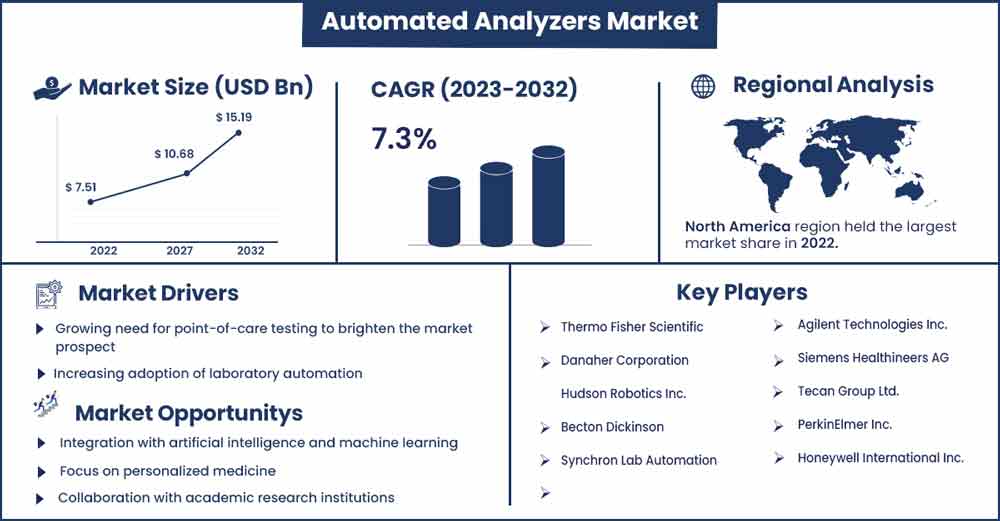November 2025
The global automated analyzers market size was evaluated at USD 7.51 billion in 2022 and is expected to touch around USD 15.19 billion by 2032, growing at a noteworthy CAGR of 7.3% from 2023 to 2032.

Automated analyzers are devices or systems designed to perform a specific analysis or measurement automatically. These analyzers can range from small, portable devices used for basic laboratory testing to large, complex systems used in industrial, medical, or scientific applications. The automated analyzers market is for analytical instruments that use automation to carry out analytical processes. Automated analyzers are used in various industries, including pharmaceuticals, biotechnology, clinical laboratories, and research laboratories. These instruments are used to automate various analytical processes, including sample preparation, sample analysis, and data interpretation. They can analyze various samples, including blood, urine, tissues, and environmental samples. Automated analyzers can also perform multiple tests simultaneously, increasing efficiency and productivity in the laboratory.
The increased demand for automated analyzers market has been pushed due to the Increasing demand for faster and more accurate diagnostic tests. With the growing prevalence of chronic diseases, the rising demand for diagnostic tests that can provide quick and accurate results is fueling the market. The surging prevalence of chronic diseases such as diabetes, cancer, and cardiovascular diseases contributes to the automated analyzers market.
Regional Snapshots:
The automated analyzers market has been expected to experience the highest market share from the North America region during the forecast period. In North America, government and private insurance companies offer favorable reimbursement policies for diagnostic tests, which has increased the adoption of automated analyzers in clinical laboratories. Furthermore, North America has several major players in the automated analyzers market, such as Thermo Fisher Scientific Inc., Danaher Corporation, and Abbott Laboratories. The presence of these companies has led to the development of advanced automated analyzers and increased competition in the market.
Report Highlights:
Automated Analyzers Market Report Scope:
| Report Coverage | Details |
| Market Revenue in 2023 | USD 8.05 Billion |
| Projected Forecast Revenue by 2032 | USD 15.19 Billion |
| Growth Rate from 2023 to 2032 | CAGR of 7.3% |
| Largest Market | North America |
| Base Year | 2022 |
| Forecast Period | 2023 to 2032 |
| Regions Covered | North America, Europe, Asia-Pacific, Latin America, and Middle East & Africa |
Market Dynamics:
Drivers:
With the growing prevalence of chronic diseases and the increasing importance of early diagnosis, there is a rising demand for faster and more accurate diagnostic tests. Automated analyzers are increasingly being used in clinical laboratories to improve the efficiency and accuracy of diagnostic testing. Automated analyzers can perform multiple tests simultaneously, significantly reducing testing time and improving test results' accuracy. They can analyze a wide range of samples, including blood, urine, tissues, and environmental samples, and perform tests for various diseases and conditions.
Automated analyzers can perform tests with high precision and accuracy, reducing the risk of errors in the testing process. This is particularly important for tests that require a high level of accuracy, such as cancer marker tests, where even small errors can have significant consequences. In addition to reducing testing time and improving accuracy, automated analyzers can also help to reduce costs in the long run. By automating the testing process, laboratories can reduce the need for manual labor, which can save time and money. As the demand for faster and more accurate diagnostic tests continues to increase, the use of automated analyzers is expected to become more widespread. With advancements in technology, automated analyzers are becoming more advanced and efficient and are capable of performing a wider range of tests than ever before.
Opportunities:
Integration with artificial intelligence (AI) and machine learning (ML) is set to transform the automated analyzers market, creating new opportunities for growth and innovation. By leveraging AI and ML, automated analyzers can enhance their capabilities and provide more accurate and personalized diagnostic testing. AI and ML can be used to analyze large amounts of data generated by automated analyzers, helping to identify patterns and trends that may be difficult to detect using traditional methods. This can lead to more accurate and timely diagnoses and more effective treatment plans. In addition, AI and ML can help reduce healthcare professionals' workload by automating routine tasks, allowing them to focus on more complex diagnostic and treatment decisions.
Recent Developments:
Major Key Players:
Market Segmentation:
By Analyzer
By Application
Buy this Research Report@ https://www.precedenceresearch.com/checkout/2735
You can place an order or ask any questions, please feel free to contact at sales@precedenceresearch.com | +1 9197 992 333
November 2025
October 2025
July 2025
July 2025